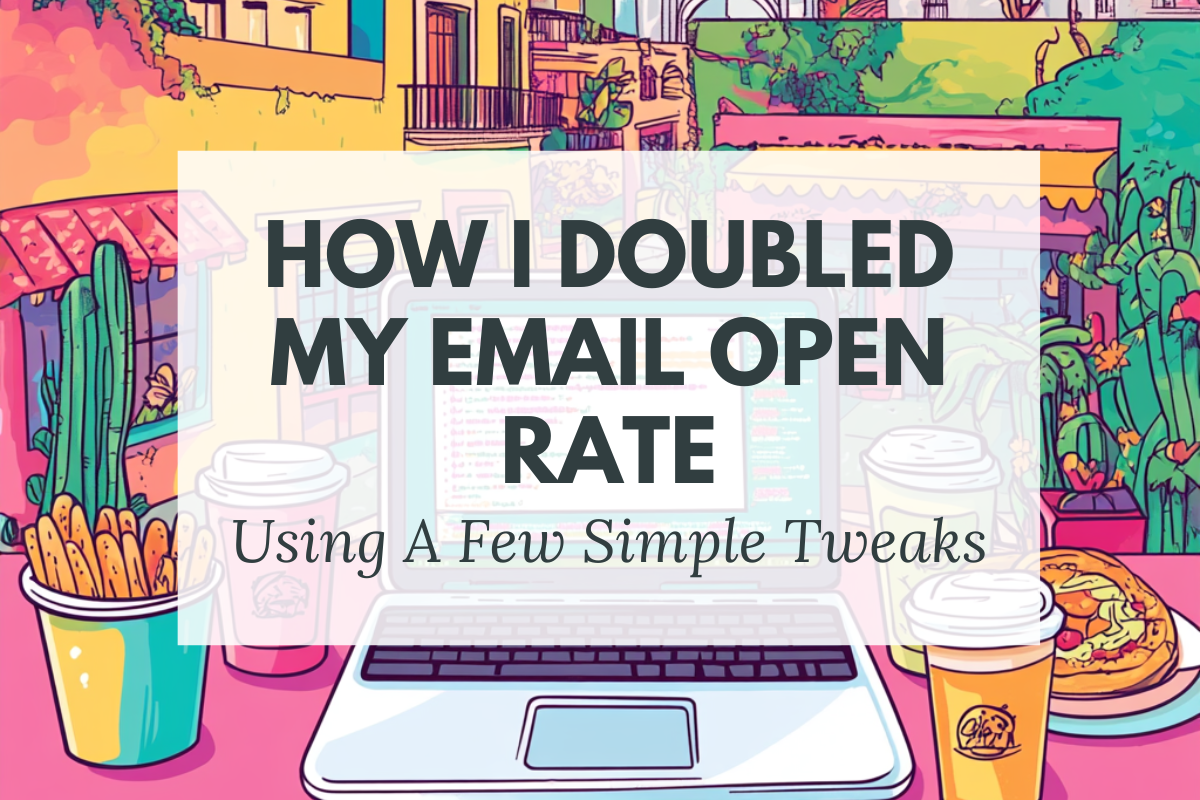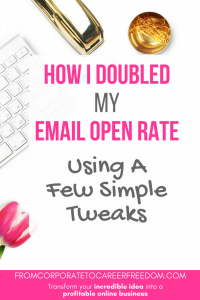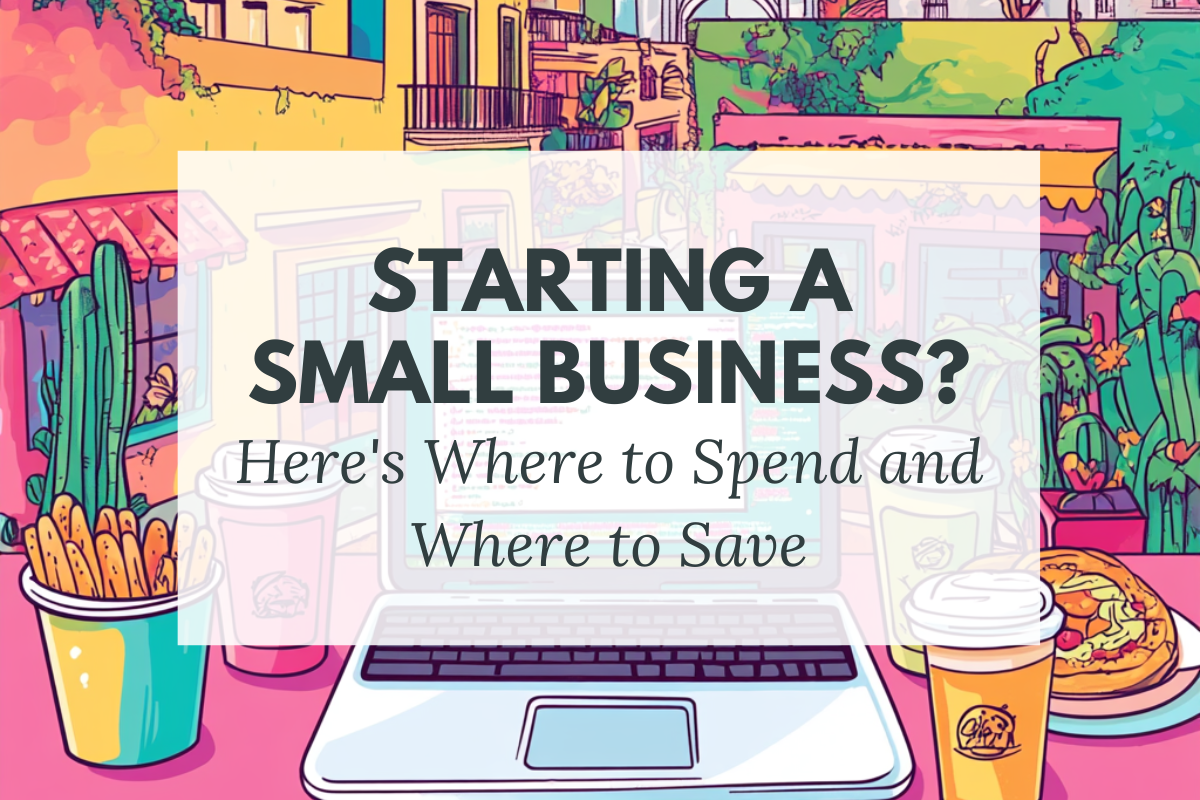I see lots of articles about how to increase your email list, and how it can rapidly grow your business. I see the same messages from marketing gurus day in day out, the same promises made (how to grow your list to 1000! 3000! 10000!), many similar statistics quoted. Whilst growing a list is important, much of this discussion seems to overlook a really important factor when it comes to email marketing and that’s your email open rate:
If your subscribers aren’t opening your emails, then your strategy isn’t working
Open rate always seems like the poor neglected brother of list building. Let’s put an end to that neglect once and for all because you are wasting your time building a list if your subscribers aren’t reading your emails. Once I understood the importance of open rate, I managed to double mine just by making a few simple tweaks to my strategy. This post is going to explain what that strategy was, and how you can use it to create emails that:
- Your subscribers will love
- Will give you a great open rate
Please note this post may contain affiliate links. Please refer to my disclosure for more information.
Some slightly-technical did-you-know stuff first
Before I begin talking about strategy, I want to explain something that I recently learned about how your emails are delivered because I think this is really going to help you focus on upping your game when it comes to email.
When you send emails to your list, your email is assessed using something called a Sender Score. This is a trust score that email providers use to decide if you are authentic or spam. You are scored every time you send an email. If subscribers are opening and reading your email, then your score goes up. If they are unsubscribing or marking you as spam, your score goes down. So what happens if your score drops?
You have less chance of future emails getting to your recipients
Interesting, huh? It just goes to show how important a good quality email strategy is. Without further ado, let’s start looking at some tips on how you can improve yours:
Step 1: Understand it is a privilege to be in someone’s email inbox
An email inbox is a pretty personal thing. It’s also a potential time-thief in our lives. I’m always hugely grateful (and humbled) when someone signs up to my list. In all honesty, it still fills me with nerves when I see a new name pop up in my autoresponder because I just hope I can live up to their expectations.
To be invited to send an email to someone who you’ve never met is a huge honor. Take the responsibility seriously and always remember that above everything else. Think about how you can serve and delight your subscribers, give back to them, and build a relationship.
Step 2: Understand who your subscribers are and what they need from you
If you want subscribers to open your email, then it’s pretty obvious that you need to give them something worth opening. To do this, you need to understand exactly who your customers and subscribers are and why they signed up to your list.
Are they looking for:
- Information?
- Advice?
- Support?
- Exclusive promotions?
- Inspiration?
What your subscribers want really depends on your business model, but you must understand this first before deciding on how you can best serve them. If in doubt, ask!
Step 3: Be clear about your aims as a business
Be honest: are you building an email list because you’ve been told by half-a-dozen internet marketers that it’s what you have to do? Yes, list building is important, but if you don’t have a purpose to it, it is irrelevant. Think about what your goals are as a business:
- What do you want to achieve? Are you looking at turning subscribers into customers? Or is your goal about retaining existing customers?
- What do you need to promote?
- How is your email list going to help you market your products and services?
Always start with the end goal in mind. Have a clear strategy about what you want to achieve from your email list over the next month, 3 months and 12 months, and work backwards from there. This will give you far better focus about what emails you are going to send and why, so you don’t go into panic-mode and simply fire random emails off to your subscribers in the hope that some of them buy from you.
Step 4: Build your email strategy
It isn’t enough to have an email list that you simply send emails to occasionally. As a business owner, you need to think about your email list as a key asset to your business; one that requires a sound and solid strategy. So set aside some time to put together an email strategy. Here’s what is should contain:
Part A: Frequency of campaign
Decide how frequently you want to email your subscribers. There are a couple of things to consider:
- Email too infrequently and your subscribers might forget who you are. Part of email marketing should always be about building an awareness of your brand, and you won’t be able to do that if you are only sending emails ad-hoc.
- Likewise, think carefully about bombarding your subscribers with daily emails. Remember that the average person gets 121 emails in their inbox PER DAY (according to Radicati). People are busy and have busy lives, so make the time they spend scanning their inbox easier, not harder.
- It can be a good idea to ‘brand’ your emails to a particular day of the week or day of the month so people know when they will receive it and why. For example, if you are a diet coach you could have a Monday Motivation email campaign where you send a motivating email every Monday to your subscribers to help get them through the most difficult diet day of the week.
Part B: Purpose of campaign
If you really want your email campaign to work for your business, then you need to spend quality time thinking about how you are going to give your emails some meaning. They should always have a purpose to them and that theme should be consistent across the majority of emails you send (with the exception of promotional ones). Here are a couple of examples of great email campaigns that have a really clear purpose, and do exceptionally well as a result:
- Hoxton Hotel. This is an old campaign and they don’t run it any more but it was a killer. First, let me ask: have you ever stayed in a hotel in London? I’ve had plenty of business trips (and personal trips) there over the years and I still wince when I look at hotel room prices. London is notoriously expensive. Honestly, I’ve stayed in so-called ‘luxury’ hotels in the past where I’ve paid $200+ for the privilege of a room the size of a cupboard. Anyway, I digress. Hoxton did this amazing limited £1 sale on their room rates every month which was so popular that it nearly always crashed their site. But there purpose was clear: offering a headline-grabbing promotion to build a customer base and increase awareness of their brand. From that point of view, it was highly successful.
- One email I always open is from Laura Roeder AKA LKR The Dash. The emails are consistently laid out and sectioned so I’m always 100% clear what I can expect when I open them. She always provides some new, informative news or facts about social media that are relevant to me as a business owner, and she couples this with a really helpful tip that I can use to improve my business. Her aim is to inform and help her subscribers and position herself as an authority in her subject, and she does that incredibly well by offering valuable and new information and by doing it consistently.
Step 5: Create a winning design
Hubspot did some research into email marketing and found that 88% of subscribers preferred to receive html emails instead of plain text.
Design is clearly important to subscribers, and they want information that is well formatted and easy to digest. This includes headings, images and structure.
Most email platforms will give you the option of sending an email in either html or plain text. I use Convert Kit for my email provider, because it gives me so many easy options when it comes to creating the best looking email (plus, they have great deliverability – hugely important if you actually want your emails landing in an inbox rather than spam folder!).
I used to be an advocate for plain text (I liked the simplicity and elegance of writing as I would write a letter to a friend) but I’ve since switched to html, and it had a positive impact on my open rates as soon as I made the switch.
Spend time thinking about how you want to design your email so that it is going to appeal to your ideal customer. If you are a product-based company, consider adding in high-quality images that people can quickly scan. Consider adding sub-sections to divide your newsletter up into easily digestible sections, like the LKR The Dash one I mentioned previously.
Step 6: Craft excellent copy
The same rules you follow to craft high-quality blog posts also apply when writing high-quality emails. Here’s a breakdown of what you need to consider:
Part A: An attention-grabbing subject line
The subject line has to be attention-grabbing. These types of subject headings tend to do well:
- Something personal
- Highlighting an offer, discount, or limited-time deal
- A funny subject heading
- Something with an air of mystery to it
- A taste of what to expect in the full email
Avoid the following mistakes, as they can put readers off (at worse, they can land you in the spam folder):
- All upper case. No need to shout in an email, is there?
- Read this, hi, open me, I saw this…. All classic tactics used by spam
- Anything generic is just too boring to be opened
Part B: Add a curiosity-building introduction paragraph
If your subscribers open the email, your next job is to grab their attention enough to read the full email (and hopefully click through to your links to lead them back to your website). It is worth spending the time crafting a dazzling opening paragraph that will really grab their attention and tempt them to read on. One good tactic is to let them know to expect something interesting further down the email.
Part C: Use meaningful links (that don’t look dodgy)
A clearly-worded, meaningful link is more likely to be clicked on than either a vague one or something that looks slightly spam-like. So, avoid:
Bad: Click here
Bad: Anexampleofabademaillink.com/164396943
Good: Grab your 10% discount today
Part D: Personalize the email
The Aberdeen group carried out research into click-through rates on emails and found that a personalized email improved click-through rates by 14% and conversion rates by 10%.
 Try personalizing your emails by addressing your subscriber by their first name. Most (if not all) of the big email providers will allow you to do this with ease.
Try personalizing your emails by addressing your subscriber by their first name. Most (if not all) of the big email providers will allow you to do this with ease.
Step 7: Split test your emails to optimise your email open rate
Finally, if you really want to improve your open rates, one of the best tactics to try is to split test your campaigns. Create two different emails and send each to half your subscriber list, and simply monitor the results. As with anything online, the data is there for you to analyze, so testing should never be overlooked when you are striving to improve your online business.
Action Steps
Here’s what you can do today to get your email marketing up to scratch:
- Think about your target customer. How are you serving them on email at the moment? How can you improve on that and serve them better?
- Find out what your subscribers are seeking out from you. Have a look at your past emails. Which one had the best open rate?
- Write down a 3-month goal and 12-month goal for your email marketing. How are your future email campaigns going to support your business growth?
- Decide on what your individual email campaigns are going to be, and the frequency of those campaigns.
- Start writing your copy. Re-write and re-draft until you have fine-tuned your writing style. Make it engaging, on-brand and clickable.
- Think about how you want to design your email. Is it interesting to the reader? Is it in keeping with your brand.
- Finally, invest in a market-leadign email marketing platform so that you can ensure your emails are getting good deliverability and look great. I’d strongly recommend Convert Kit, as that’s the one I use and love. I’ve included a link below to their free trial.
| SIGN UP TO YOUR FREE TRIAL OF CONVERT KIT HERE |
Conclusion
Putting these strategies in place has personally allowed me to double the open rate on my email campaigns so I have absolute faith that they work. Open rates are never something that should be overlooked or placed at the bottom of your priority list. After all, if you’ve put time and effort into building your email list, then surely you should spend an equal amount of effort into making sure your emails are read.









Of all the marketing strategies, I think email marketing is perhaps the most ignored one. Thanks for this informative post which explains exactly how to make it work for your business/blog.